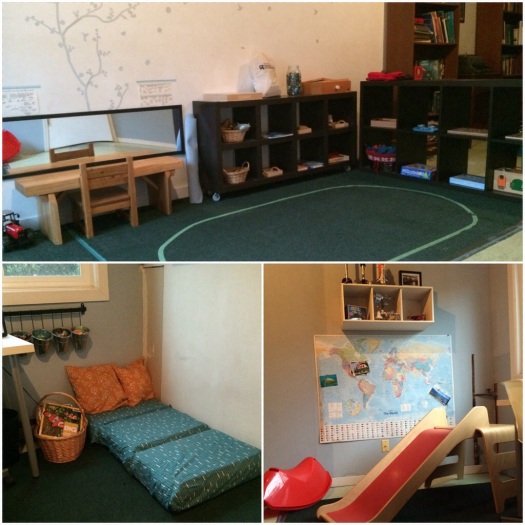Quentin’s second birthday is fast approaching. It was time to sit back and evaluate our spaces in the home. Here’s what I found.
Our “Space” (above) is where the boys spend the majority of their time. It is big enough for Quentin to hop/roll/tumble but also to work quietly. His small table and mirror are our greatest assets in this space. He uses them every day. His blue work mat is rolled up and sits to the right of his table. He is able to get it out, unroll it and roll it up independently. Not all Montessori homes have work mats but for us it has worked well to help define his work area. He knows when he takes something off the shelves that it goes to his table or mat. It also helps him recognize that he already has a material out and needs to clean it up before getting another one. The ellipse on the floor is also not a “must have” in Montessori homes, but it was easy to do, and we play lots of movement games such as “Walking on the Line”. It is just green painters tape, and I like that it gives us opportunities to do some controlled gross motor movement. We also sit on the line to do finger plays and nursery rhymes.
On top of his shelves is the light box Anthony and I made. Quentin loves it and when he uses it on his table next to the mirror it opens up a whole new world of perspective for him. There are many good light panels/boxes out there but I suppose I should add the disclaimer that whether homemade or store bought, make sure all components are safe for indoor use (don’t get hot), aren’t too bright and aren’t used for an extended period of time especially in a dark room.
His shelves (which I will do a separate, specific post on tomorrow) house all this materials used in this space. At almost 2 we have a really good mix of all 5 areas of the Montessori classroom without looking to match it exactly. There are spaces for lots of language activities like matching cards and model animals, and spaces for sensorial activities like nesting dolls, puzzles and building blocks. There are a few early Maths spaces and some Practical Life such as pouring and transferring activities. There is also a space for art materials. A brand new addition to the top of the shelves (not pictured) is our Montessori Continents globe. Quentin knows where the water is and names it as “the Ocean” and sometimes even “the Pacific Ocean” but that is very abstract and we never really focus on it.
Our cosy reading corner and basket of books gets used frequently. We keep “research books” (as Anthony calls them) here. Non fiction books with real image pictures. Usually with animals for Quentin.
Our gross motor area with the slide and rocker are a favourite and get used every day. The rocker is light enough for Quentin to move independently. He usually moves it so that he can see himself in his work mirror when he rocks. We also keep homemade bean bags and a little container of bubble solution ready to use here.
At two years old what are our must haves for this space?
– Baskets with handles
– Wooden trays with handles
– Real image books
– Vocabulary cards
– Puzzles
– Art
– A range of activities that vary from gross motor to fine motor
If he wishes to work, we must provide him with things on which he can exercise an intelligent activity. – Maria Montessori
Our Practical Life Areas. I didn’t include a picture of our weaning table which still sits beside Quentin’s Kitchen. The kitchen and pantry have evolved over time, but have never been more important in Quentin’s day than they are now. Having a place to store his things that he can access independently is of the utmost importance in any Montessori space. I love that we can keep them all together. He clears his dishes and tools from his table after every meal without us having to prompt him now. We keep a little glass pitcher of water on his weaning table for when he wants a drink.
The laundry line was a homemade Christmas gift from my father. It is kept in our laundry area and Quentin uses it frequently there and on the rugs in our “Space”. All of these items allow Quentin to actually contribute to our family’s day to day life. He bakes, sweeps, dusts, cleans, and does the laundry along side us. He is not in the way, he is actually helping.

Our Care of Self area in the bathroom remains the same. Our little sink and Toileting Area has not changed much since I set them up when we first started really getting into Toilet Learning with Quentin. The only thing not shown above is the little container of soaps and creams that Quentin can access in our bathroom vanity cupboard. Our bathroom is tiny but this little area has worked really well for us. Like everywhere else we keep it tidy and well stocked and Quentin does the rest.
So that’s it really. Could we do with less? Absolutely. Do I want to add more? Of course I do. We have enough to have a good rotation of different materials that offer him a range of experiences. Many of which are homemade, second hand or come from our small community’s fantastic toy lending library. When I’m looking for something specific and well made I shop here.
Nothing really needs changing and nothing monumental is happening. Except for the fact that unbelievably, and against all odds we will very soon have a two year old.










